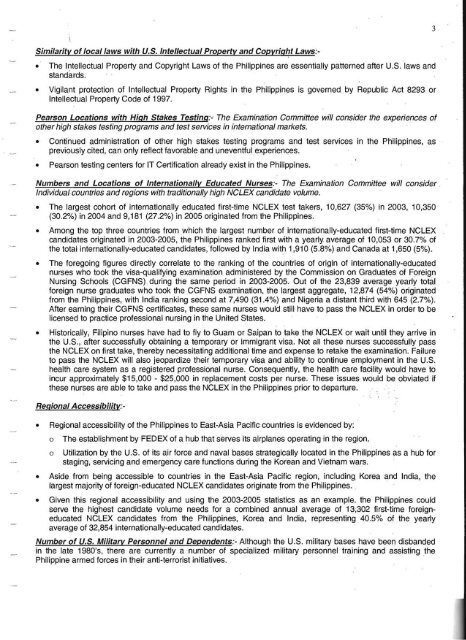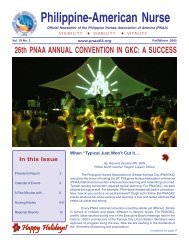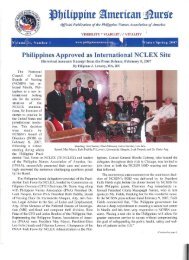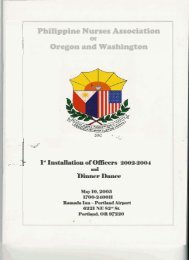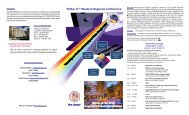2004 PNAA Biennial Report
2004 PNAA Biennial Report
2004 PNAA Biennial Report
You also want an ePaper? Increase the reach of your titles
YUMPU automatically turns print PDFs into web optimized ePapers that Google loves.
3<br />
Similarity of local laws with U.S. Intellectual Property and Copyrig~t Laws:<br />
• The Intellectual Property and Copyright Laws of the Philippines are essentially patterned after U.S. laws and<br />
standards.<br />
• Vigilant protection of Intellectual Property Rights in the Philippines is governed by Republic Act 8293 or<br />
Intellectual Property Code of 1997.<br />
Pearson Locations with High Stakes Testing:- The Examination Committee will consider the experiences of<br />
other high stakes testing programs and test seNices in international markets.<br />
• Continued administration of other high stakes testing programs and test services in the Philippines, as<br />
previously cited, can only reflect favorable and uneventful experiences.<br />
• Pearson testing centers for IT Certification already exist in the Philippines.<br />
Numbers and Locations of Internationally Educated Nurses:- The Examination Committee will consider<br />
Individual countries and regions with traditionally high NCLEX candidate volume.<br />
• The largest cohort of internationally educated first-time NCLEX test takers, 10,627 (35%) in 2003, 10,350<br />
(30.2%) in <strong>2004</strong> and 9,181 (27.2%) in 2005 originated from the Philippines.<br />
• Among the top three countries from which the largest number of internationally-educated first-time NCLEX<br />
candidates originated in 2003-2005, the Philippines ranked first with a yearly average of 10,053 or 30.7% of<br />
the total internationally-educated candidates,followed by India with 1,910 (5.8%) and Canada at 1,650 (5%).<br />
• The foregoing figures directly correlate to the ranking of the countries of origin of internationally-educated<br />
nurses who took the visa-qualifying examination administered by the Commission on Graduates of Foreign<br />
Nursing Schools (CGFNS) . during the same period in 2003-2005. Out of the 23,839 average yearly total<br />
foreign nurse graduates who took the CGFNS examination, the largest aggregate, 12,874 (54%) originated<br />
from the Philippines, with India ranking second at 7,490 (31.4%) and Nigeria a distant third with 645 (2.7%).<br />
After earning their CGFNS certificates, these same nurses would still have to pass the NCLEX in order to be<br />
licensed to practice professional nursing in the United States.<br />
• Historically, Filipino nurses have had to fly to Guam or Saipan to take the NCLEX or wait until they arrive in<br />
the U.S., after successfully obtaining a temporary or immigrant visa. Not all these nurses successfully pass<br />
the NCLEX on first take, thereby necessitating additional time and expense to retake the examination. Failure<br />
to pass the NCLEX will also jeopardize their temporary visa and ability to continue employment in the U.S.<br />
health care system as a registered professional nurse. Consequently, the health care facility would have to<br />
incur approximately $15,000 - $25,000 in replacement costs per nurse. These issues would be obviated if<br />
these nurses are able to take and pass the NCLEX in the Philippines prior to departure.<br />
Regional Accessibility:<br />
• Regional accessibility of the Philippines to East-Asia Pacific countries is evidenced by:<br />
o<br />
o<br />
The establishment by FEDEX of a hub that serves its airplanes operating in the region.<br />
Utilization by the U.S. of its air force and naval bases strategically located in the Philippines as a hub for<br />
staging, serviCing and emergency care functions during the Korean and Vietnam wars.<br />
• Aside from being accessible to countries in the East-Asia Pacific region, including, Korea and India, the<br />
largest majority of foreign-educated NCLEX candidates originate from the Philippines.<br />
• Given this regional accessibility and using the 2003-2005 statistics as an example. the Philippines could<br />
serve the highest candidate volume needs for a combined annual average of 13;302 first-time foreigneducated<br />
NCLEX candidates from the Philippines, Korea and India, representing 40.5% of the yearly<br />
average of 32,854internationally~educated candidates. .<br />
Number of U.S. Military Personnel and Dependents:- Although the U.S. military bases have bee" disbanded<br />
in the late 1980's, there are currently a number of specialized military personnel training and assisting the<br />
Philippine armed forces in their anti-terrorist initiatives.


